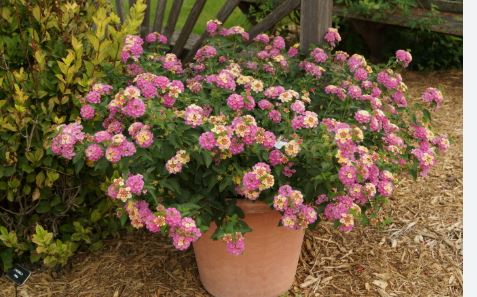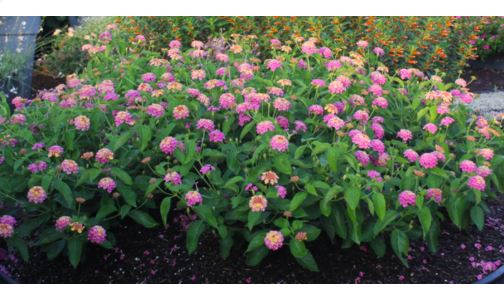
Lantana plants are vibrant, flowering shrubs or perennials known for their clustered blooms in shades like pink, orange, yellow, red, and white, often shifting colors as they age. Native to tropical Americas and Africa, primarily Lantana camara or hybrids with Lantana montevidensis, they are prized for attracting butterflies and hummingbirds. Their ornamental appeal makes them a staple in gardens and landscapes worldwide.
These plants thrive in full sun and well-drained, slightly acidic soil, tolerating heat, drought, and poor soils. Grown as perennials in USDA zones 8–11 or annuals in colder zones, they suit containers, borders, or groundcovers. Their adaptability and low maintenance make them ideal for sunny, warm climates.
Lantanas bloom from late spring to frost, or year-round in frost-free areas, with sterile hybrids preventing invasive spread. Their flowers support pollinators, but some produce toxic berries, requiring caution around pets or children. Pruning encourages continuous blooming and maintains shape.
Challenges include potential invasiveness in warm climates and toxicity concerns. Regular deadheading and monitoring control spread, while their deer-resistant foliage enhances garden ecosystems. Lantanas’ vibrant colors and ecological benefits make them a versatile choice for urban and rural landscaping.

Pink Lantana Varieties
Bandana Pink
Bandana Pink is a compact Lantana camara hybrid (12–18 inches tall and wide) with flowers that open honey-yellow and mature to rose-pink, creating a bicolor effect. Originating from tropical Americas and bred in the United States, it thrives in full sun and well-drained soil, blooming from summer to fall in USDA zones 9–11 (annual in colder zones). Its mounding habit suits containers, hanging baskets, or borders, and its drought tolerance and pollinator appeal (butterflies, hummingbirds) make it ideal for low-maintenance gardens.
Hot Pink Little Lucky
Hot Pink Little Lucky is a dwarf Lantana camara cultivar (10–16 inches tall and wide) with vibrant pink and yellow flower clusters that bloom up to three weeks earlier than other lantanas. Developed in the United States, it thrives in full sun, well-drained soil, and humid conditions, making it perfect for containers or border fronts in zones 9–11. Its compact, heat-tolerant nature and continuous blooms until frost attract pollinators, ensuring a colorful, low-care garden addition.
Pink Caprice
Pink Caprice is a spreading Lantana camara variety (2–3 feet tall, 4–6 feet wide) with pink flowers accented by yellow centers, fading to softer pink hues. Native to tropical Americas, it’s a non-sterile cultivar that blooms from spring to frost in zones 9–11, thriving in full sun and well-drained soil. Its sprawling habit suits groundcovers or large containers, but it requires monitoring for invasiveness due to berry production. Its pollinator-friendly blooms are ideal for vibrant landscapes.
Bloomify Rose
Bloomify Rose is a sterile Lantana camara cultivar (12–24 inches tall and wide) with rose-pink flowers, developed by the University of Florida to prevent invasive spread. It thrives in full sun and well-drained soil, blooming from late spring to frost in zones 9–11. Its mounding habit suits borders, containers, or mass plantings, and its non-seeding nature ensures more energy for flowering, attracting butterflies and hummingbirds. It’s a low-maintenance, eco-friendly choice for gardens.
Pink Dawn
Pink Dawn is a low-growing Lantana camara hybrid (10–14 inches tall, 12–18 inches wide) with soft pink flowers and yellow centers that mature to pastel pink. Originating from tropical Americas and bred for garden use, it thrives in full sun and well-drained soil, ideal for hanging baskets or small beds in zones 9–11. Its compact size, drought tolerance, and pollinator-attracting blooms make it a charming, low-maintenance option for patios or hedges.
Santana Banana Punch
Santana Banana Punch is a spreading Lantana camara hybrid (20 inches tall, 48 inches wide) with soft pink and creamy yellow flowers, leaning toward pastel pink tones. Developed in the United States, it blooms from summer to frost in zones 9–11, thriving in full sun and well-drained soil. Its trailing habit is perfect for groundcovers or hanging baskets, and its heat tolerance and pollinator appeal make it a low-care, vibrant garden choice.
Bandolero Lychee
Bandolero Lychee is a Lantana camara hybrid (18–22 inches tall and wide) with hot pink and yellow flower clusters, emphasizing vivid pink hues. Bred in the United States, it thrives in full sun and well-drained soil, blooming from late spring to frost in zones 9–11. Its mounding habit suits large containers or garden beds, and its heat and humidity tolerance, along with pollinator-friendly flowers, make it ideal for colorful, low-maintenance landscapes.
Dwarf Pink
Dwarf Pink, or Lantana camara Dwarf Pink, is a true dwarf cultivar (2–3 feet tall and wide) with pastel pink, yellow, and cream flower clusters. Native to tropical Americas, it’s a non-spreading shrub that thrives in full sun and well-drained soil, blooming from spring to fall in zones 9–11. Its compact form is perfect for containers or low borders, and its drought tolerance and butterfly-attracting blooms suit water-wise gardens.
Confetti
Confetti is a spreading Lantana camara cultivar (2–3 feet tall, 4–6 feet wide) with multicolored flowers blending pink, yellow, and magenta, with pink often dominant. Originating from tropical Americas, it blooms from spring to frost in zones 9–11, thriving in full sun and well-drained soil. Its sprawling habit is ideal for groundcovers or mass plantings, but its non-sterile nature requires monitoring for invasiveness. Its vibrant blooms attract pollinators.
Ham and Eggs
Ham and Eggs is a cold-hardy Lantana camara cultivar (2–4 feet tall and wide) with pink and yellow flowers, offering a soft pink display, and is hardy to zone 7b. Originating from tropical Americas, it thrives in full sun and well-drained soil, blooming from summer to fall in zones 7–11. Its mounding habit suits borders or containers, and its phytophthora resistance and pollinator-friendly blooms make it a reliable, colorful garden choice.